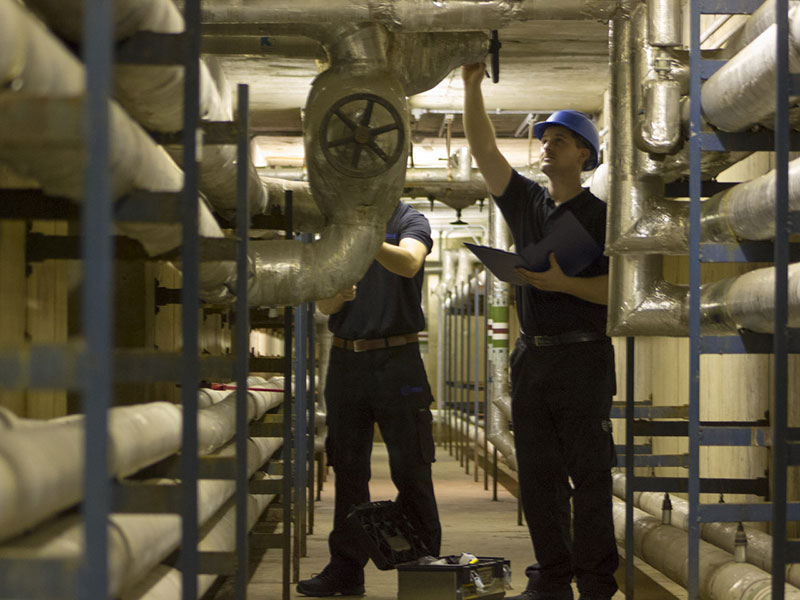How long does an asbestos survey take?
When it comes to managing the risks that asbestos can pose to human health on any given premises, there are very few measures as important as an asbestos survey.
Undertaking a ‘materials assessment’ of a property for which you are responsible will be crucial to your efforts to find where asbestos-containing materials (ACMs) might be present on your site – as well as the type and quantity of those materials. This, in turn, will enable you to make informed and responsible decisions about how to safely manage any asbestos-containing materials on your site.

If you are the “dutyholder” for a given non-domestic building, as set out by regulation 4 of the Control of Asbestos Regulations 2012 (CAR 2012), one of your duties will be to take reasonable steps to ascertain whether there are ACMs on the premises.
Depending on the circumstances of your particular premises, you might be required to arrange an asbestos survey. But if this is the case for you, how long can you expect the process to take?
What is the aim of an asbestos survey?
A dutyholder arranges for an asbestos survey to be carried out on their site, so that they can determine whether there are any asbestos-containing materials on the premises – and if so, exactly where those materials are on the site, as well as their amount and condition.
Essentially, the overarching aim of an asbestos survey is to help the dutyholder with their broader asbestos management efforts. If you don’t know critical information about the location and condition of any asbestos in a building for which you are responsible, you won’t be able to make the right decisions about how to manage those materials which can pose subsequently pose a perilous risk to human health.
The information that you gather from an asbestos survey will enable you to put together an asbestos register, which will show the parts of the property where the material has been found to be present.
What happens during an asbestos survey?
There are different types of asbestos survey – as we will explain in more detail below – and the exact process naturally differs depending on the type of survey undertaken.
Nonetheless, there are certain consistent aspects to be aware of. The surveying process typically begins with an initial walk-through. The idea behind this is to – among other things – identify anything that might serve as an obstruction, as well as to risk-assess the premises and check the validity of the plans.
As the survey gets underway in earnest, the surveyor will work methodically through the site, using their skill, knowledge, and judgement to pinpoint materials that they suspect contain asbestos. In the case of these suspect materials, the surveyor will take a sample, which will be sent to the lab for analysis to confirm whether asbestos is present.
Before the asbestos surveying process is due to begin on your premises, you should ensure no staff are in the work areas, so that the survey team can do their work alone. If the survey will be a refurbishment or demolition survey, there shouldn’t be anyone in the building, unless stringent controls are in place.
How long does an asbestos survey take to complete?
As an approximate guide, you should allow a minimum of one day for an asbestos survey to be undertaken on your site. However, the exact time you can expect your next asbestos survey to take will depend on a range of factors, such as:
The type of asbestos survey
The different types of asbestos survey available can vary in how long they take. When a lot of people think of asbestos surveys, for example, they immediately think of asbestos management surveys.
An asbestos management survey is comprehensive enough to detect asbestos in a building, but also non-intrusive in nature, causing no damage to the property. Although this type of survey might involve the lifting of carpets or the unscrewing of certain areas, this is as intrusive as you can expect such a survey to get.
The non-intrusive nature of an asbestos management survey means that it typically takes less time to complete than an asbestos refurbishment or demolition survey. This type of survey – as the name suggests – is carried out prior to refurbishment or demolition work on a property. It is an intrusive survey, designed to detect asbestos even in parts of a building where it might otherwise go undetected. It therefore shouldn’t surprise you to learn that this type of survey necessitates a longer amount of time being spent on-site.
Another type of survey to be aware of is the asbestos reinspection survey. This type of survey is undertaken on a building that has already been subject to an asbestos management survey. The reinspection survey is designed to check all positive samples previously found on the premises, in order to ascertain whether factors such as accidental damage or ‘wear and tear’ might have caused a change in condition of any asbestos-containing materials. In most cases where an asbestos reinspection survey is necessary, it will need to be carried out on the given site every 12 months.
The size of the building
It might seem an obvious point to make, but some duty-holders can easily overlook that it will take a longer amount of time to complete an asbestos survey on a larger building, than a smaller one.
If, then, you are responsible for a larger building for which you will need to arrange an asbestos survey, you should be mindful that the work may need to take place over several days or multiple visits.
The age of the building
With the use of asbestos in the UK not having been banned until 1999, if the given building was erected prior to 2000, there is a strong chance that asbestos will be present on-site.
Also bear in mind that older buildings can be more prone to the effects of ‘wear and tear’, which might heighten the risk of accidental disturbance or damage to any asbestos on the premises. This factor means that an older building will typically require a more detailed – and therefore more time-consuming – asbestos survey than a newer structure.
The maintenance of the building
Failure to maintain a building well – even if this was the fault of previous people who were responsible for the premises, rather than you – can accelerate the ‘wear and tear’ we mentioned above.
Again, this can mean there is a need for a more comprehensive, detailed and time-consuming survey, so that the surveyor can be confident of having ascertained all potential asbestos risks in the building. A poorly maintained building might have sustained damage – including to asbestos materials – that a well-maintained building doesn’t suffer from, which can equate to higher risks.
What happens after an asbestos survey?
Presuming you have appointed a professional surveyor to carry out this crucial work on the property for which you are the dutyholder, once the survey is complete, you can expect to receive a comprehensive survey report.
This report will set out the results of the analysis of suspect materials on your site, so that you will know what materials on your site contain asbestos. This will be accompanied by recommendations, which will greatly assist your efforts to control the risks that such materials could pose to people working in or otherwise using your premises.
It is important to appreciate that your work on managing the asbestos risks on your premises won’t be done once the asbestos survey has been carried out. That is because you will need to act on any issues raised, with some of these potentially being in need of more urgent resolution than others.
As we mentioned above, there is a broader “duty to manage” the asbestos risks on your site in accordance with regulation 4 of CAR 2012, and this involves much more than simply arranging an asbestos survey.
The information you gain from the asbestos survey results will enable you to put together a comprehensive asbestos management plan, which should outline in detail how you will manage the risks that asbestos materials present on your premises. Then, you will need to act on that plan, and arrange to periodically review and monitor it, so that your plan stays relevant and up to date.
Ensure your asbestos survey is kept up to date
As mentioned, you will need to keep your asbestos management plan up to date, and that means keeping your asbestos survey up to date, too.
The exact answer to the question of how often you will need to have an asbestos survey undertaken on your premises will depend on circumstances such as the type of survey, what work you might plan to do on the property, and if you are presently managing asbestos risks on the site.
If, for instance, you plan to carry out refurbishment work on the property, there is a strong chance that you will need to arrange for a dedicated refurbishment survey as we detailed earlier, instead of being able to depend on the management survey. And as we also stated earlier, periodic reinspection surveys can be crucial for checking whether the condition of previously identified ACMs on your premises might have deteriorated since the last survey.
Is there any aspect of having an asbestos survey carried out on your site that you are unsure about, or would appreciate help with? Perhaps you are seeking out reputable and accredited asbestos surveyors? Whatever your query might be in relation to asbestos surveys, please feel free to call Oracle Solutions today or to ask for a quote via email.

Written by Callum McDonald
Callum McDonald is an expert in asbestos quality management, ensuring rigorous adherence to regulations and high-quality standards in removal projects. His focus on enhancing quality and client satisfaction makes him a crucial asset in safety and compliance within the field. Callum's expertise in technical support and oversight of licensed works underscores his commitment to excellence in asbestos management, providing invaluable guidance to clients in this specialised area.
